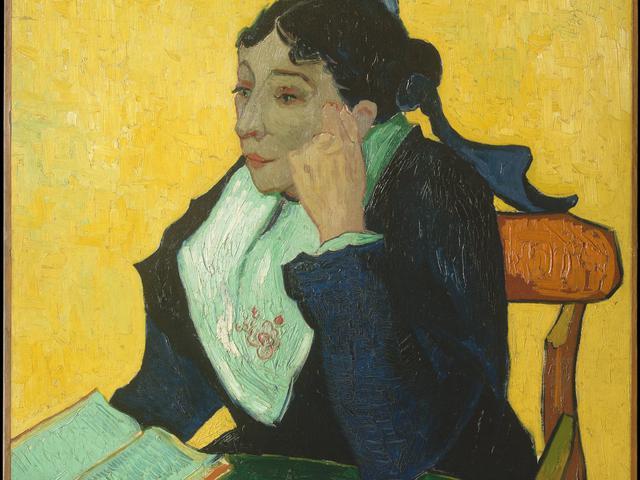The Arlesienne

Van Gogh painted a total of 7 portraits of Madame Ginoux, owner of the Café de la Gare in Arles, France. Van Gogh came to know Madame Ginoux, or Marie Jullian, the wife of Joseph-Michel Ginoux, while staying at the café from May to September 1888 before moving to the Yellow House. In August 1888, he painted The Night Café, depicting the interior of Ginoux's café.
Shortly after Gauguin's arrival at the Yellow House, Madame Ginoux agreed to sit for a portrait of Gauguin and Van Gogh. Within an hour, Gauguin created a preparatory charcoal sketch for a later painting, while at the same time Van Gogh used the thick jute canvas that Gauguin had brought with him to Arles and painted his entire portrait.
The first version of Van Gogh's portrait in Madame Ginoux, L'Arlesienne: Madame Ginoux with Gloves and Umbrella, is now in the Musée d'Orsay in Paris. Van Gogh created the second version based on the composition of his first portrait, but with a more complete quality. He used a more saturated, densely applied color and has her sitting in front of books instead of gloves and umbrella. This second version, L'Arlesienne: Madame Ginoux with Books, is now in the Metropolitan Museum of Art in New York.
In 1890, during his stay at the asylum in Saint-Remy, Van Gogh produced five more portraits of Madame Ginoux; this time based on Gauguin's drawing rather than his own portrait.
Vincent Willem van Gogh was a Dutch post-impressionist painter who is among the most famous and influential figures in the history of Western art. In just over a decade, he created nearly 2,100 works of art, including about 860 oil paintings, most of them in the last two years of his life. They include landscapes, still lifes, portraits and self-portraits, and are characterized by bold colors and dramatic, impulsive and expressive brushstrokes that contributed to the foundations of modern art. His suicide at age 37 followed years of mental illness and poverty.
Born into an upper-middle-class family, Van Gogh drew as a child and was serious, calm and thoughtful. As a young man he worked as an art dealer, often traveling, but became depressed after being transferred to London. He turned to religion and spent time as a Protestant missionary in southern Belgium. He was sidetracked by ill health and loneliness before beginning to paint in 1881, having moved home with his parents. His younger brother, Theo, supported him financially, and the two maintained a long letter correspondence.
© Tourblink